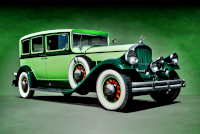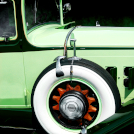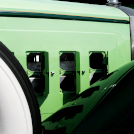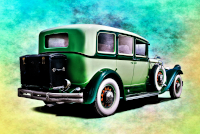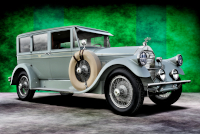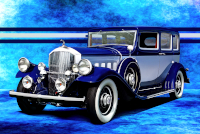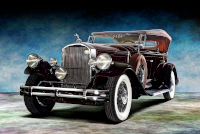Location:
Radnor Hunt Concours d'Elegance, 2007
Owner: Robert & Jill Rank | Quakertown, Pennsylvania
Prologue:
Time to revisit 2007, just once more. I always liked this two-tone green sedan, but lately eschewed retouching these old images. The originals seemed to me so very stuck in the past, and I did not feel that I would add much to the portfolio. But at the outset, I do need a representative to fill the 1930 model year, the only year for the Model A, B, and C nomenclature. And yes, I still like the colors. As it turns out, a quick reprise produces a bunch of pop, syrup, and fizz, to say nothing of the patina on that old brightwork. This is a nice classic, a car posed well, and I'm happy to fit it into the plan.
- - - - - - - - - -
► Image Source: Nikon D200 (10.2 MP)
References:
- Ralston, Marc. "Pierce-Arrow" A.S. Barnes & Co., Inc., San Diego, CA. 1980, page 148-150, 232
- Automobile Quarterly, Volume 6, Number 3, Third Quarter 1968, "Pierce-Arrow: An American Aristocrat" by Maurice D. Hendry, The Kutztown Publishing Company, Inc., Kutztown, PA, page 257-258
- Automobile Quarterly, Volume 28, Number 4, Fourth Quarter 1990, "The Last Years of Luxury" by John C. Meyer III, The Kutztown Publishing Company, Inc., Kutztown, PA, page 73, 88-89
The straight-eight appeared in 1929; long in development, its arrival coincides with Studebaker's benevolent takeover. From 1929 through 1930, Studebaker will support much of the roughed-out Pierce-Arrow manufacturing process in South Bend, Indiana, granting Pierce-Arrow the time (and money) to re-tool in Buffalo. The process brings Pierce-Arrow into the modern era, not merely with the introduction of the straight 8-cylinder, but also with bodies of stamped steel construction.
No more sixes. No more aluminum bodies. The competition eagerly labels new Pierce-Arrow cars as expensive Studebakers. But of course their slander is unfair, (and Studebaker ought not to be maligned). Just as Pierce-Arrow demonstrated fanatical attention to its own manufacturing processes, so did they devise an excessive quality control program at South Bend to supervise those outsourced components. And of course the arrangement is temporary, and Studebaker the angel investor of sorts that allows Pierce-Arrow to make good on plans to modernize.
The first representative we can share from these Studebaker transition years is a 1930 Model B, fittingly produced in five-passenger sedan configuration. I say "fitting" because Pierce-Arrow seemed to excel at sedan production through the antique era, to say nothing of the broader shift in the market away from open touring cars in favor of simple, closed bodies that are always shielded from the weather.
Pierce-Arrow also produced a seven-passenger enclosed-drive limousine on this same 139-inch wheelbase. Without proper identification in any related material, I am assuming that this car is the more common five-passenger sedan. Outwardly, the two display no major difference. Inside, the enclosed-drive car would include a partition, as well as jump seats for extra passengers.
I am tempted to list the car as an unrestored example. 'Refurbished' might be the best term. The paint is newish, but the brightwork remains patina'd and the interior is original. The product is a nice, clean classic, the type that for many years represented popular expectations, prior to the concours craze and million-dollar restorations. Sufficient, this Model B provides a springboard for us to discuss much about changing technology and the new era in Pierce-Arrow history, which of course is also its final chapter.
Motor: 5997.7 cc (366 cubic inches) inline 8-cylinder, cast-iron block | 88.9 mm x 120.65 mm (3½" x 4¾")
The Model B uses the middle displacement of three available, producing ten more horses than the C, and seven fewer than the A. According to Ralston, "There appears to be needless extra production cost for little practical difference in power." As new owner and benevolent partner, Studebaker produced the rough casts for the first straight-eight Pierce-Arrow motors in South Bend, Indiana as of 1929. These blocks are nine-bearing units exclusive to Pierce-Arrow, produced under quality controllers sent from Buffalo until such time as Pierce-Arrow upgraded its tooling. During this period, the Studebaker factory cast the manufacture date and time into the block so that engineers and metalurgists could track the cast quality and make fine adjustments.
Valvetrain: L-head, 2 valves per cylinder
Aspiration: single Stromberg Model UU2 dual-updraft carburetor
Power: 125 hp @ 3,800 rpm
Drivetrain: Clark 4-speed manual transmission, rear-wheel drive
Only the 1930 Model A and Model B use the Clark unit, marking a very brief return of a 4-speed gearbox not seen since 1919.
Front Suspension: semi-elliptic leaf springs
Rear Suspension: live axle with three-quarter-elliptic leaf spings
Architecture: steel chassis, steel body panels on wood frame
Steel finally replaced aluminum in 1929. While economically prudent to remain afloat during the Great Depression, part of the process relied on Studebaker's shared production capability. Pierce-Arrow began producing open body styles, whereas Studebaker pressed sedan bodies in South Bend, Indiana, which they then shipped out to Buffalo. By 1931, Pierce-Arrow brought its steel tooling on line and resumed production. But during transition, Pierce-Arrow maintained quality control inspectors in South Bend to uphold standards. Automobile Quarterly notes: "The sedan bodies at South Bend were reputed to have more inspectors from Buffalo supervising their construction than there were workmen actually building bodies!"
Wheelbase: 3,530.6 mm (139 inches)
Etymology:
In 1930, Pierce-Arrow replace 1929's wheelbase nomenclature (the Model 133 and Model 143) with a simple alphabetical format. The new A, B, and C designations refer to three displacements. In this case, the Model A uses the largest, most powerful motor—next the Model B, and least the Model C, which "was in effect a modified 1929 standard 133 model," according to Ralston. So really, the Model A and Model B are the new models with new tooling for 1930. All Model A cars also use a longer 144-inch wheelbase, whereas the Model B uses either a 134 or 139-inch wheelbase depending on body style.
In Pierce-Arrow fashion, the company will change nomenclature again in 1931, returning to numbers. In this case, 1930 is the only year for simple A, B, C naming, at least since 1901 when they began with the Model A (but skipped B and C and landed directly on D). New 1931 cars run from the Model 43, 42, and 41. But note here that Pierce-Arrow also reverse the ascension of the model line. Whereas the 1930 Model A is the top-line car in this production series, the 1931 Model 41 is counterintuitively the top-line car for its production series. Pierce-Arrow continued these backward numbers into 1932 with the Models 54, 53, 52, and 51. In conclusion, Depression-era Pierce-Arrow cars make very little sense in terms of the thinking behind the model names.
Figures:
Ralston cites 6,916 units for the entire 1930 production run, which means no breakdown of model and style survives. (Or, as he has inferred, Pierce-Arrow record-keeping was spotty.) Suffice to say, Pierce-Arrow sold a lot of sedans through the 1920s, and the trend continued into the following decade, with many surviving today.
Minty Fresh: Two-Tone Livery on a Pierce-Arrow Sedan
For all these years, I still love two-tone green coachwork. Difficult to see at a distance, this Model B sedan includes a faint ochre pinstripe just above the belt line. That dark green binding frames the side windows and sweeps elegantly around the rear compartment, anticipating the height of the mounted trunk. As with many examples from this transitional period, Pierce-Arrow painted the vertical grille, in this case matching the running gear. Atop sits the period-correct archer mascot with a helmet and the more fantastical harp-shaped bow.
Artillery Wheels: The Wood Wheel Option Enters the Classic Era
Pierce-Arrow retained standard hickory wood spoked wheels, offering wire wheels as an option. At least four-wheel hydraulic brakes reduce the spoke length, demanding bigger hubs, and the wheels are of a smaller, more modern size. But wood is a remnant of antique opulence. Typical that Pierce-Arrow would cling to the old glory vestiges, whereas no such remnant would be seen on a contemporary Cadillac or Packard.
Running Remnants: Pierce-Arrow Lights and Running Gear Updated for Modern Motoring
These modernized Pierce-Arrow cars carry over the Herbert M. Dawley integrated headlamp configuration with little difficulty. However, the leading aspect of the fender changes, drawing a leaner sweep to match a lower stance. Pierce-Arrow conceived the shape in 1929, and will use the same design through 1932, without variation among body styles.
Note that the lighted running boards, which are regular equipment (if not strictly ubiquitous) on Pierce-Arrow cars from 1930 to 1931, also appear in the same form on the 1919 Model 66-A-4 designed by Harley Earl. I cannot say for certain whether Earl is the originator, or whether Pierce-Arrow offered this option prior to 1919, but most cars of that vintage and any in between lack the same feature. Given the respect heaped upon Earl by the history books, one could speculate. In any case, a few 1929 examples use lights on the running boards, many that are somewhat larger, and some that rather obstruct the cleanliness of line. So what we see here is that, in 1930, Pierce-Arrow chose to copy the clean, round lights Earl used in 1919 and standardize their installation across the range.
Stylized Mascot: The Final Year for the Art Deco Version of Pierce-Arrow's Archer
This Model B uses the original archer concept, the 1928 Art Deco design. He is behelmeted, leaps forward in an altogether stylized pose, and wields a harp-shaped bow. His is an artistic interpretation. But in 1930, Pierce-Arrow engage General Motors Art and Colour Department, Turnstedt Division, to create a more natural archer. Artist Bonnie Lemm pens the revision, and Frederick Guntinni sculpts the clay model. Yes, the story of the janitor posing for the archer is mostly true. Except the janitor in question was Albert J. Gonas, himself a young apprentice in the Department made to sweep up as an underling. He recounted that William Schnell, the director, suggested he pose for Bonnie, which suggestion Gonas did not initially take seriously. But the goal was to create a wholly natural figure. In this manner, the revised archer is a Beaux-Arts sculpture that replaces an Art Deco motif. Both are charming, though the pose created by Lemm and Guntinni is naturally evocative.
Last Updated: Mar 26, 2025

